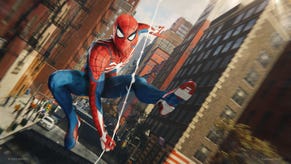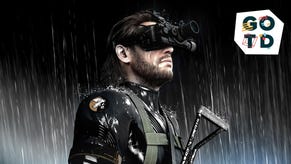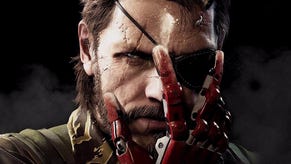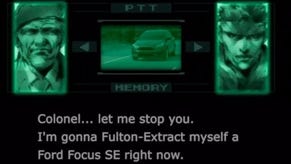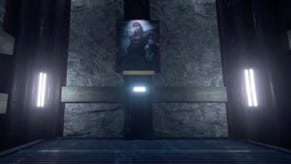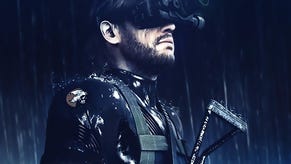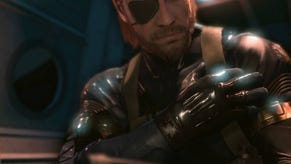War has changed. But has Hideo Kojima?
Let the legend come back to life.
The Metal Gear series is 25 while its creator, Hideo Kojima, is now 50. Spending half of your life devoted to a single series takes commitment, and indeed Kojima has frequently expressed a desire over the past decade to part with the franchise that made his name. And yet, he keeps coming back. Again and again. After a while, you have to ask why.
Kojima has occasionally branched out to other projects, like the mech-based sci-fi action series Zone of the Enders or the solar-powered, dungeon-crawling Boktai. But when it comes to direct involvement in high budget games, he can't seem to escape the bombastic, bewildering war machine that's become synonymous with his surname.

Out at Konami's remote snow-covered lodge in rural Nasu, Japan, I ask Kojima what keeps inspiring him to return for yet another encore role in the director's chair. "If I'm to be completely honest, as soon as I say I'm going to make another Metal Gear, it's easier for me to get a budget, to get approval from the company to move on with this project," he replies modestly. "I think we make different attempts to try something extraordinary, something out of the ordinary. Just by saying 'I'm going to create MGS5' that in and of itself, allows me to try several different things."
It's a tough offer to turn down. Who wouldn't want a bigger motion capture studio, the man behind Looper's make-up building prosthetics for your animation team and the chance to hire movie star talent like Kiefer Sutherland to take on the lead role? Kojima has the chance to be a Hollywood director without having to live the Hollywood lifestyle.
This puts the director in a very enviable position. Few big budget game developers - if any - have the sort of freedom Kojima has, and it shows. Where other triple-A blockbusters feel like a design by committee, Kojima Productions' efforts have a distinct feel to them, with their Sergio Leone-inspired visual flair, Tarantino-esque dichotomy of violence set to pop music, rambling philosophical monologues, operatic villains, and a smorgasbord of comic Easter eggs. Love it or hate it, there's certainly no mistaking a Kojima game for anyone else's work.
This is because Kojima has a far more hands-on approach to his team's games than perhaps anyone in the industry. He personally edits each and every one of his game's trailers from a private office separate from his usual workspace. This trailer-editing room is a beige windowless carpeted affair that looks like part 70s radio broadcasting studio and part living room - complete with a couch for napping. Beyond this, he's present at every cut-scene's motion capture filming where he ensures the final cut fulfils his vision. The rest of the time he works in a sprawling set of cubicles in Konami's Tokyo headquarters where he's positioned in a corner, surrounded by the writing and art teams.
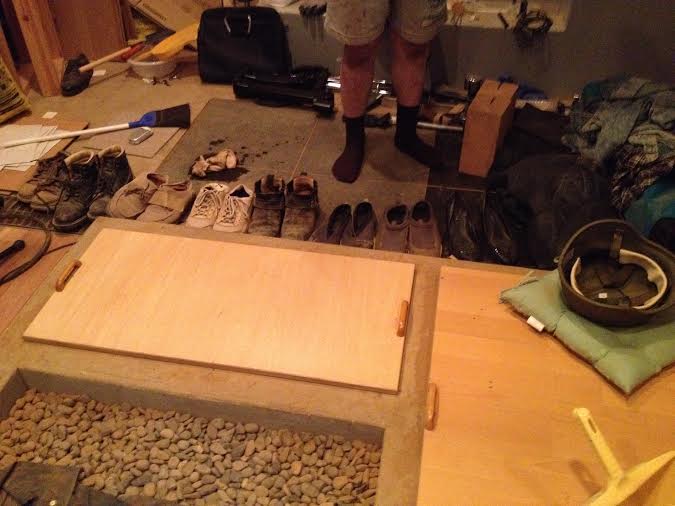
But, as the old Spider-Man adage goes, with great video game developing power comes great video game developing responsibility. Has Kojima gotten into a position where his ideas are no longer challenged by his peers?
"Metal Gear, as a brand, I want this to continue..." Kojima replies somewhat cagily through the translator. "That said, I charge my staff members, my personnel, to step up to the challenge [of making a game without me] and that has proven to be a bit difficult. One thing that hasn't changed is ideally I would want some staff members to take after Metal Gear. [I'd] overlook it as a producer, and dedicate myself to making something different."
I ask how he hopes to nurture his staff's creativity so they don't simply try to emulate him - after all, the best creative transformations occur when the torch goes to someone willing to try something new, like when Eiji Aonuma took over Zelda after Shigeru Miyamoto.
"The Tokyo team, I've been working with them altogether, so I believe they will create something in a very similar stance to what I've been creating so far," Kojima says. "Now for our LA studio - that's the studio we tried to gather developers from all over the world and get them together, [so] I believe they will be able to create something different. I don't want to push any ideas on them. I would like to take a step back and work as a producer for whatever they come up with."
That's the kicker. Kojima knows he's not the only idea man in town. Heck, he knows he's not the only one on his team. The problem is that nobody else seems to know that. In the early days Kojima built his empire by cheekily inserting aspects of himself into his products (like his name as an easter egg in MGS1's famous Psycho Mantis fight). But as Phantom Pain rolls around an equal credit can be given over to character and mechanical designer Yoji Shinkawa, CG art director Hideki Sasaki, technical director Junji Tago and lighting artist Masayuki Suzuki all proceeding Kojima's credit as the producer, game designer and director.
"In past games, you have a five-minute cut-scene where someone tells you how badly they were tortured and how badly they wanted to see you, and what happened to them up to that point. I intentionally stayed away from that this time."
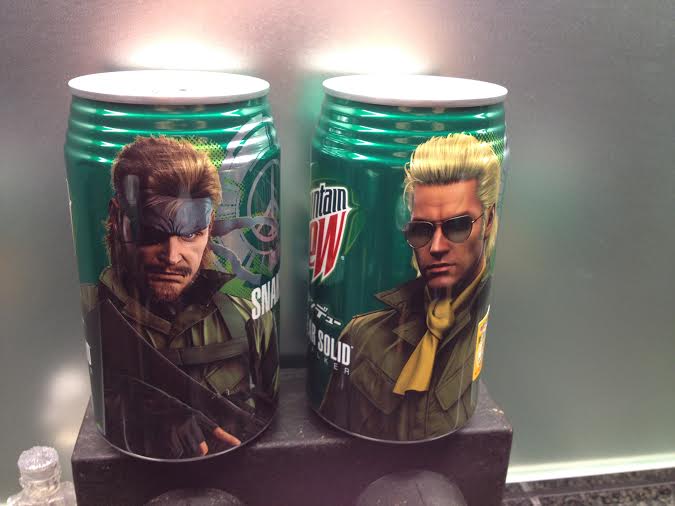
It's hard to look at Kojima and not think of his legendary hero, Solid Snake, who spent the majority of MGS4 grunting while younger nano-machine-enhanced soldiers creepily worked together in unison, like ants carving out a functional network of tunnels. Reason would have it that it's lonely at the top and one has to wonder how does a man with this much power survey for an honest opinion?
Despite his fame and status, Kojima is heavily derided for his use of incredibly lengthy cuts-cenes, something he made little effort to curtail in MGS4. I tell him my view on the matter is based on a quote by Roger Ebert: "No good movie is too long and no bad movie is short enough," and apply the same principle to cut-scenes. This being the case, I suggest that some of Metal Gear's cut-scenes are too long to convey what they need to. I ask if he gets second opinions from focus groups and colleagues or if he's perhaps concerned that he'll second guess himself too much if he lets outside opinion sway his artistic vision.
"Ultimately, it's what I believe," he says. "It comes down to what I think. If I think it's too long, I cut it short. That said, of course we rely on focus groups, on monitoring, on testing. I try to get all the information that I can. But another thing that's very important is we always need to regulate how much information we give to the player. How much are we stacking the player with information? And for cut-scenes - especially for briefing - it's kind of necessary."
But just because Kojima's flair for spectacle remains doesn't mean he's comfortable regurgitating the same trademark flourishes that have made him famous. His technique has changed over the years and MGS5 could represent his greatest stylistic shift yet.
For starters, Kojima has rearranged his cinematic sensibilities to better serve the gameplay. As such, Ground Zeroes only features two cut-scenes of any notable length: one at the beginning, and one at the very end. "We need to give an intro and an outro to people, but in the middle of the game I want to stay away as much as possible for cut-scenes, so for this Metal Gear, especially between missions, I tried [to have] as little cut-scenes as I could," he explains.
"For example you'll see that when you rescue Chico it's a very small cut-scene... In past games, you have a five-minute cut-scene where Chico tells you how badly he was tortured and how badly he wanted to see you, and what happened to him up to that point, then maybe add some dramatic music and make it a very strong scene for the player, but I intentionally stayed away from that this time... All that story, all that background will come together through picking up items, through picking up cassettes."
This will no doubt please the franchise's most die hard fans, as perhaps the Metal Gear series' most divisive quality is its incredibly convoluted story. Even at a press event with other Metal Gear fans who write about video games for a living, the general understanding of certain basic principles like "who are we fighting and why?" were shrouded in a murky web of half-remembered knowledge from scenes we may or may not have seen several years ago. This puts Kojima in the awkward position of having to make a story that pleases his detail oriented followers while remaining simple enough to be grasped by newcomers. Kojima doesn't seem bothered by this. In fact, he seems to relish in that challenge of spinning a new yarn in his labyrinthine canvas.
"This time I changed the method of storytelling, so for people who have played Peace Walker and have that background with Chico or Paz, [it] will make it easier to relate to these characters," he says later in a group interview. "If it's people that have played other Metal Gear games but not Peace Walker, or people who haven't played Metal Gear games at all, they will get a different feeling and understanding of the game. This is something that I intentionally tried to set this way.... I wanted to make a game where depending on the information and background the player has, and the experience the player has, it will feel like something different."
"Another thing that I'm considering is taking cooking lessons. I don't think anyone would like what I cook, but it would be fun."

"For people who have played Peace Walker, you can tell them 'go and rescue Paz and Chico' [and] they will know who they're going after. But for people who haven't played it, they'll hear 'go and rescue this boy and this girl.' I think most people will be able to relate to that," he says. "It's pretty much 'go and rescue Princess Peach.'... I think that's really natural."
It's not just Kojima the game designer who's changed either. Kojima the director is becoming a little less John Woo and a little more Alfonso Cuaron with his fondness of long tracking shots. "Ideally I wanted to create an open-world game where all the cut-scenes are in one shot and they make a smooth transition into the game. So it would be a game where from the opening to ending it would be almost only one camera," he says, noting that he wants to give the cinematics more of a "documentary touch". "That was kind of the concept that I had in mind for this game."
But what about Kojima the man? What do we really know about this guy besides his penchant for action movies and convoluted political satire? My time with the director is limited, so I don't get to delve too deeply into this, but when asked about his day-to-day affairs and hobbies, his answer surprises me. "I was really into building models," he tells me. "But there were two problems with that. One is when I got married my wife threw away all my modelling tools [and] kits, so I haven't done that in 24 years... The other reason is that Shinkawa is too good at modelling and doing sculptures, so it really pisses me off when someone really that good is doing that next to me," he laughs.
"Originally that's what I wanted to do. Something more analogue, more than digital. Something like sculptures and whatnot. So I am strongly considering going back to that after 24 years of not doing it."
Kojima has one other potential hobby he's been seriously thinking of pursing. "Another thing that I'm considering is taking cooking lessons," he says. "It's creating something, so I really like it." He then jokes, "I don't think anyone would like what I cook, but it would be fun."
Unfortunately, there's one inconvenient practicality preventing him from going whole hog into this pastime. "I would have to go a little bit far away from the office, so that's where I'm having second thoughts," he ponders. "But in the end that's the same as creating games."
Okay, maybe it's not exactly the same thing as creating games, but I see what he's getting at. Kojima's appetite for good food won't be news to anyone who follows him on Twitter, or who witnessed the strangely fetishised fried eggs that punctuated Metal Gear Solid 4.

When it comes to the finer points of Kojima's work - the frequent, ponderous cut-scenes, the voice of his lead character, the overall directing style - the Metal Gear creator has changed a lot over the years. But these are all surface details. Ultimately, Kojima's still Kojima. He's still wistfully daydreaming about a career outside of Metal Gear, and still proving himself as perhaps the medium's most stylish director. In an era where big budget blockbusters see one person's vision swallowed by a sea of decisions made by hundreds of employees and dozens of execs, Kojima should be commended for managing to retain his personal stamp on every game bearing his company's moniker.
But behind the old warhorse is a desire not to change per se, but to grow. And growth is what's kept Metal Gear's shrapnel splintered heart alive all these years. It's easy to look at two games in the Call of Duty, Assassin's Creed, or Halo series and not be able to spot the difference, whereas the Metal Gear series' jumpy, rambunctious spirit makes different acts in the same game seem like they could be from entirely separate franchises.
One look back at his career and it's clear that Kojima's never been a man to blindly follow current trends. When everyone went to fully controllable 3D cameras he retained his top-down perspective for MGS3's initial release. When the rest of the industry moved to open-worlds, he kept his relatively linear designs in MGS4. When the general push was to go bigger and more epic, he decided to follow up MGS4 with the PSP outing Peace Walker. Finally, after several years, he's making the triple-A open world blockbuster fans have clamoured for, but he certainly didn't rush into it. As ever in his career, Kojima is only making these changes under his own terms.



